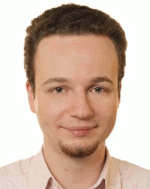 |
|
Biography
Zlatan Stanojevic studied at the Technische Universität Wien where he received the BSc degree in electrical engineering and the degree of Diplomingenieur in Microelectronics in 2007 and 2009, respectively. He is currently working at the Institute for Microelectronics at the Technische Universität Wien. His research interests include semi-classical modeling of carrier transport, thermoelectric and optical effects in low-dimensional structures.
Surface Roughness Scattering in Non-Planar Channels
Non-planar transistor channels used in tri-gate or Gate-All-Around (GAA) device architectures offer superior electrostatic control, which reduces short-channel effects. The performance-limiting process in these devices is Surface-Roughness Scattering (SRS), as it is more pronounced in these devices than in planar technologies. This has two reasons: one is that there are more surfaces to scatter off and the other is that sidewall roughness or Line-Edge-Roughness (LER) are harder to control in the fabrication process.
Being of such importance, it is surprising to find that a thorough perturbative treatment of SRS is missing in the literature. Most low-field mobility calculations for non-planar channels employ phenomenological descriptions or extensions of SRS models for planar structures. Commonly, tri-gate channels are modeled as three independent planar channels at the top and each sidewall; in GAA channels, mobility is either assumed to be proportional to the sixth power of the diameter or empirical formulas are given for the SRS rate.
The only work known to us that rigorously treats SRS for a one-Dimensional Electron Gas (1DEG) is due to Jin et al. in J. Appl. Phys 102, 083715 (2007). The authors, however, rely on cylindrical symmetry of both real and k-space; this means that, first, the model cannot be used for non-cylindrical geometries and, second, band anisotropy is completely neglected. Channel orientation is likely to play an important role in SRS, as experiments with planar Metal-Oxide-Semiconductor Field-Effect Transistors (MOSFETs) show.
In our work, we investigated the effect of bandstructure anisotropy and channel orientation on SRS in non-planar channels, such as tri-gate and GAA structures. A new formalism was introduced for calculating SRS rates for non-planar structures. The formalism is an extension of the theory by Prange and Nee for planar structures, which has been widely used for calculating the conductivity of inversion layers and thin films. We derive matrix elements for open and closed surfaces of arbitrary shape. The matrix elements are based on the notion of "form functions", a generalization of the form factors used for planar structures. The form functions are transformed into momentum space to obtain "spectral form functions", which govern the momentum conservation in the plane of quantum confinement. They replace the sharp momentum conservation known from the Prange-Nee formalism for planar structures with smooth functions. Furthermore, the anisotropy of the band structure is fully taken into account. Numerical experiments performed on tri-gate and GAA cross-sections indicate that SRS is greatly influenced by band anisotropy and channel orientation.

Fig. 1: Illustration of the computational procedure for calculating the spectral form functions: Form functions are formed for each pair of wave functions. This is done analogously to the form factors for planar structures. The form functions are then resampled and transformed via Fast Fourier Transformation (FFT) to obtain the spectral form functions.



